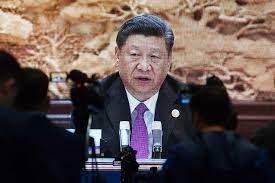Syed Ali Nawaz Gilani
“The rise of China is one of the most transformative global events of our time. Over the past few decades, China has emerged as a major economic power, and it is now poised to become a leading player in international affairs. This transformation has significant implications for the world, and it presents both challenges and opportunities for the international community.” – Ban Ki-moon, former Secretary-General of the United Nations.
Recently held annual meetings of China’s legislature and top political advisory body in Beijing which were attended by nearly 3000 delegates across China means the National People’s Congress (NPC) which is China’s most powerful state organ.
Whereas another Chinese People’s Political Consultative Conference (CPPCC), draws its members from various sectors of society. Their debates were worth noting for emerging social and economic issues. The speeches made by Chinese President Xi Jinping and all outgoing and incoming leaders being named after the 20th CPC NPC in October 2022, formalize leadership for China. Newly appointed China’s foreign minister Mr. Qin Gang, appear first time as Foreign Minister and portray the Chinese mind at Press Conference after meetings. Prior to the meetings, Mr. Guan Tao, Global Chief Economist of Bank of China’s BOC International told the Global Times.
“One of the most closely watched items is how China will set its growth target and relevant policies,” He was of the view that officials are likely to set a “more active tone” for the current year, given the acceleration to economic activity since the zero COVID strategy was abandoned at the end of 2022.
China has implemented various strategies to revamp its economy and improve its global position in recent years. Here are some of them.
Made in China 2025: This is a plan aimed at transforming China into a high-tech manufacturing hub. It aims to upgrade the country’s manufacturing industry and move it up the value chain. The plan focuses on industries such as robotics, aerospace, high-tech shipping, and other advanced technologies.
Belt and Road Initiative (BRI): This is a massive infrastructure development project aimed at connecting China to the rest of the world through a network of land and sea routes. The BRI involves investments in over 60 countries, to improve trade and economic cooperation.
Dual Circulation Strategy: This is a new economic strategy that China has adopted, with a focus on stimulating domestic consumption while maintaining export-oriented growth. This strategy is designed to make China less reliant on exports and foreign technology, with a greater emphasis on promoting domestic innovation and development.
Digital Transformation: China is investing heavily in digital technology, to become a world leader in areas such as artificial intelligence, 5G networks, and blockchain technology. The government is also promoting e-commerce and other digital platforms to support economic growth.
Environmental Protection: China is also working to address environmental issues such as pollution and climate change. The government has implemented several policies aimed at promoting green growth and sustainable development.
China’s strategies aim to improve its economic competitiveness, reduce its dependence on foreign technology, and promote sustainable growth. These initiatives have helped China become a major player in the global economy and continue to shape its economic and political influence.
Transforming China is an ongoing process that has been underway for several decades. Since the introduction of economic reforms in 1978, China has experienced rapid economic growth and social development. However, this has come with a range of challenges and opportunities, and the government has implemented various strategies to address them.
One of the key aspects of transforming China has been the shift from a planned economy to a market-oriented one. In the early years of reform, the government introduced a series of measures aimed at decentralizing economic decision-making and promoting entrepreneurship. This led to the emergence of a vibrant private sector and the growth of the foreign investment.
Another important aspect of transforming China has been the emphasis on science and technology. China has invested heavily in research and development, with a focus on areas such as artificial intelligence, biotechnology, and renewable energy. This has helped China become a world leader in these fields and has contributed to its economic growth.
At the same time, China has also faced a range of challenges in its transformation. One of the most significant is the issue of inequality. While the overall standard of living has improved, there are still significant disparities between urban and rural areas, as well as between different regions of the country. This has led the government to introduce policies aimed at reducing inequality, such as the poverty alleviation campaign, which has lifted millions of people out of poverty.
Another challenge that China has faced is environmental degradation. Rapid industrialization and urbanization have led to significant pollution and resource depletion. In response, the government has implemented a range of policies aimed at promoting sustainable development and reducing environmental impact. For example, China has invested heavily in renewable energy, and it has also introduced policies to reduce air and water pollution.
In recent years, China has also become more assertive in its foreign policy. The Belt and Road Initiative, for example, is a major infrastructure development project that aims to connect China with countries across Asia, Africa, and Europe. This has the potential to boost trade and economic development, but it has also raised concerns about China’s geopolitical ambitions.
In addition, China has been increasingly involved in global governance. It has played an active role in international organizations such as the United Nations and has been a vocal advocate for global cooperation on issues such as climate change.
Transforming China is a complex and ongoing process that involves multiple dimensions. The government has implemented a range of policies aimed at promoting economic growth, social development, and environmental sustainability.
While there are still significant challenges, China has made impressive progress in recent decades and has become a major player in the global economy and international affairs.
syeed.gilani@gmail.com







